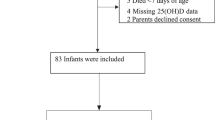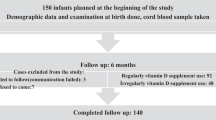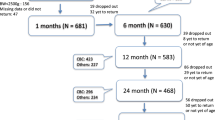Abstract
Objectives
Most authorities recommend daily supplementation of 400 IU vitamin D for all term healthy neonates throughout infancy, however this dose was shown to be inadequate in an earlier study from our institution. We planned to evaluate if supplementation of 800 IU/day in term Indian infants would reduce the prevalence of vitamin D insufficiency (VDI) at 6 months of age.
Methods
In a prospective study, we supplemented 800 IU/day of vitamin D in 70 term infants from birth till 6 months of age. Serum 25-hydroxy cholecalciferol [25(OH)D] was measured at birth and 6 months for all infants; and at 6, 10 and 14 weeks of age in subsets of 23 infants each. The primary outcome was prevalence of VDI (defined as serum 25(OH)D level < 50 nmol/L) at 6 months of age.
Results
A total of 58 out of 70 (83%) infants were followed up until 6 months of age. The median (nmol/L; IQR) serum 25(OH)D at birth and 6 months of age was 25 (12.5–35) and 92.5 (72.5–137.5), respectively. The prevalence of VDI at birth was 91.3% (63/69), which reduced to 6.9% (4/58) at 6 months of age. However, four infants (6.9%, 95% CI 1.9–16.7) developed vitamin D excess (serum 25(OH)D 250–375 nmol/L) requiring reduction of the dose of supplementation. No infant developed vitamin D toxicity (serum 25(OH)D > 375 nmol/L).
Conclusions
Daily supplementation of 800 IU of vitamin D resulted in vitamin D sufficiency in most term healthy infants at 6 months of age but with potential risk of toxicity.
This is a preview of subscription content, access via your institution
Access options
Subscribe to this journal
Receive 12 print issues and online access
$259.00 per year
only $21.58 per issue
Buy this article
- Purchase on Springer Link
- Instant access to full article PDF
Prices may be subject to local taxes which are calculated during checkout


Similar content being viewed by others
References
Holick MF. High prevalence of vitamin D inadequacy and implications for health. Mayo Clin Proc. 2006;81:353–73. https://doi.org/10.4065/81.3.353.
Holick MF, Binkley NC, Bischoff-Ferrari HA, Gordon CM, Hanley DA, Heaney RP, et al. Evaluation, treatment, and prevention of vitamin D deficiency: an Endocrine Society clinical practice guideline. J Clin Endocrinol Metab. 2011;96:1911–30. https://doi.org/10.1210/jc.2011-0385.
National Institute of Health. Dietary reference intakes for calcium and vitamin D. In: Ross AC, Taylor CL, Yaktine AL, Del Valle HB, editors. Institute of Medicine (US) Committee to review dietary reference intakes for vitamin D and calcium. Washington, DC: National Academies Press; 2011. http://www.ncbi.nlm.nih.gov/books/NBK56070/. Accessed 30 March 2017.
Merewood A, Mehta SD, Grossman X, Chen TC, Mathieu JS, Holick MF, et al. Widespread vitamin D deficiency in urban Massachusetts newborns and their mothers. Pediatrics. 2010;125:640–7. https://doi.org/10.1542/peds.2009-2158.
Merewood A, Mehta SD, Grossman X, Chen TC, Mathieu J, Holick MF, et al. Vitamin D status among 4-month-old infants in New England: a prospective cohort study. J Hum Lact J Int Lact Consult Assoc. 2012;28:159–66. https://doi.org/10.1177/0890334411434802.
Braegger C, Campoy C, Colomb V, Decsi T, Domellof M, Fewtrell M, et al. Vitamin D in the healthy European paediatric population. J Pediatr Gastroenterol Nutr. 2013;56:692–701. https://doi.org/10.1097/MPG.0b013e31828f3c05.
Agarwal R, Virmani D, Jaipal ML, Gupta S, Gupta N, Sankar MJ, et al. Vitamin D status of low birth weight infants in Delhi: a comparative study. J Trop Pediatr. 2012;58:446–50. https://doi.org/10.1093/tropej/fms013.
Marwaha RK, Tandon N, Chopra S, Agarwal N, Garg MK, Sharma B, et al. Vitamin D status in pregnant Indian women across trimesters and different seasons and its correlation with neonatal serum 25-hydroxyvitamin D levels. Br J Nutr. 2011;106:1383–9. https://doi.org/10.1017/S000711451100170X.
Hollis BW, Roos BA, Draper HH, Lambert PW. Vitamin D and its metabolites in human and bovine milk. J Nutr. 1981;111:1240–8.
Wagner CL, Greer FR. Prevention of rickets and vitamin D deficiency in infants, children, and adolescents. Pediatrics. 2008;122:1142–52. https://doi.org/10.1542/peds.2008-1862.
Canadian Paediatric Society. Vitamin D supplementation: recommendations for Canadian mothers and infants. Position statements and practice points. Ottawa, ON: Canadian Paediatric Society. http://www.cps.ca/documents/position/vitamin-d. Accessed 30 March 2017.
Gallo S, Comeau K, Vanstone C, Agellon S, Sharma A, Jones G, et al. Effect of different dosages of oral vitamin D supplementation on vitamin D status in healthy, breastfed infants: a randomized trial. JAMA. 2013;309:1785–92. https://doi.org/10.1001/jama.2013.3404.
Grant CC, Stewart AW, Scragg R, Milne T, Rowden J, Ekeroma A, et al. Vitamin D during pregnancy and infancy and infant serum 25-hydroxyvitamin D concentration. Pediatrics. 2014;133:e143–53. https://doi.org/10.1542/peds.2013-2602.
Holmlund-Suila E, Viljakainen H, Hytinantti T, Lamberg-Allardt C, Andersson S, Mäkitie O. High-dose vitamin d intervention in infants--effects on vitamin d status, calcium homeostasis, and bone strength. J Clin Endocrinol Metab. 2012;97:4139–47. https://doi.org/10.1210/jc.2012-1575.
Balasubramanian S, Dhanalakshmi K, Amperayani S. Vitamin D deficiency in childhood—a review of current guidelines on diagnosis and management. http://www.indianpediatrics.net/july2013/july-669-675.htm. Accessed 26 February 2017.
Chandy DD, Kare J, Singh SN, Agarwal A, Das V, Singh U, et al. Effect of vitamin D supplementation, directly or via breast milk for term infants, on serum 25 hydroxyvitamin D and related biochemistry, and propensity to infection: a randomised placebo-controlled trial. Br J Nutr. 2016;116:52–58. https://doi.org/10.1017/S0007114516001756.
Munns CF, Shaw N, Kiely M, Specker BL, Thacher TD, Ozono K, et al. Global consensus recommendations on prevention and management of nutritional rickets. J Clin Endocrinol Metab. 2016;101:394–415. https://doi.org/10.1210/jc.2015-2175.
Sahu M, Bhatia V, Aggarwal A, Rawat V, Saxena P, Pandey A, et al. Vitamin D deficiency in rural girls and pregnant women despite abundant sunshine in northern India. Clin Endocrinol. 2009;70:680–4. https://doi.org/10.1111/j.1365-2265.2008.03360.x.
Jain V, Gupta N, Kalaivani M, Jain A, Sinha A, Agarwal R. Vitamin D deficiency in healthy breastfed term infants at 3 months & their mothers in India: seasonal variation & determinants. Indian J Med Res. 2011;133:267–73.
Pittard WB, Geddes KM, Hulsey TC, Hollis BW. How much vitamin D for neonates? Am J Dis Child. 1991;145:1147–9.
Shakiba M, Sadr S, Nefei Z, Mozaffari-Khosravi H, Lotfi MH, Bemanian MH. Combination of bolus dose vitamin D with routine vaccination in infants: a randomised trial. Singap Med J. 2010;51:440–5.
Siafarikas A, Piazena H, Feister U, Bulsara MK, Meffert H, Hesse V. Randomised controlled trial analysing supplementation with 250 versus 500 units of vitamin D3, sun exposure and surrounding factors in breastfed infants. Arch Dis Child. 2011;96:91–95. https://doi.org/10.1136/adc.2009.178301.
Heaney RP, Davies KM, Chen TC, Holick MF, Barger-Lux MJ. Human serum 25-hydroxycholecalciferol response to extended oral dosing with cholecalciferol. Am J Clin Nutr. 2003;77:204–10.
Vieth R, Chan PC, MacFarlane GD. Efficacy and safety of vitamin D3 intake exceeding the lowest observed adverse effect level. Am J Clin Nutr. 2001;73:288–94.
Acknowledgements
We acknowledge the contributions by Mrs Shiji Binu, Mr Leslie James and Mr Bijoy Jose for assistance in analysis of blood samples. We thank all the babies enrolled in the study and their families for being part of the study and the nursing staff at AIIMS, New Delhi.
Funding
Indian Council of Medical Research (ICMR) funded the drug; laboratory tests were available as free in-house facilities.
Author information
Authors and Affiliations
Corresponding author
Ethics declarations
Conflict of interest
The authors declare that they have no conflict of interest.
Rights and permissions
About this article
Cite this article
Priyadarshi, M., Sankar, M.J., Gupta, N. et al. Efficacy of daily supplementation of 800 IU vitamin D on vitamin D status at 6 months of age in term healthy Indian infants. J Perinatol 38, 1566–1572 (2018). https://doi.org/10.1038/s41372-018-0216-6
Received:
Revised:
Accepted:
Published:
Issue Date:
DOI: https://doi.org/10.1038/s41372-018-0216-6



